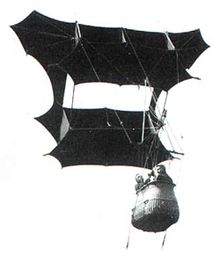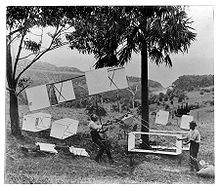- Man-lifting kite
-
 Roald Amundsen, the polar explorer, is lifted from the ground using a man-lifting kite during tests in 1909.
Roald Amundsen, the polar explorer, is lifted from the ground using a man-lifting kite during tests in 1909.
A man-lifting kite is a kite designed to lift a person from the ground. Historically, man-lifting kites have been used chiefly for reconnaissance and entertainment. Interest in their development declined with the advent of powered flight at the beginning of the 20th century.
Contents
Early history
The first records of man-lifting kites come from China. The (636) Book of Sui records that the tyrant Gao Yang, Emperor Wenxuan of Northern Qi (r. 550-559), executed prisoners by making them fly with bird-shaped kite wings (see ornithopter). For his Buddhist initiation ritual at the capital Ye, the emperor parodied the Buddhist ceremonial fangsheng 放生 "releasing caged animals (usually birds and fish)".
On one occasion the emperor visited the Tower of the Golden Phoenix to receive Buddhist ordination. He caused many prisoners condemned to death to be brought forward, had them harnessed with great bamboo mats [quchu 籧篨] as wings, and ordered them to fly down to the ground (from the top of the tower). This was called a 'liberation of living creatures'. All the prisoners died, but the emperor contemplated the spectacle with enjoyment and much laughter.[1]
The (1044) Zizhi Tongjian records that in 559, all the condemned kite test pilots died except for Eastern Wei prince Yuan Huangtou.
Gao Yang made Yuan Huangtou [Yuan Huang-Thou] and other prisoners take off from the Tower of the Phoenix attached to paper (kites in the form of) owls. Yuan Huangtou was the only one who succeeded in flying as far as the Purple Way, and there he came to earth.[2]
The Purple Way (紫陌) road was 2.5 kilometers from the approximately 33-meter Golden Phoenix Tower (金凰台). These early manned kite flights presumably "required manhandling on the ground with considerable skill, and with the intention of keeping the kites flying as long and as far as possible."[3]
In a story about the Japanese thief Ishikawa Goemon (1558–1594), he used a man-lifting kite to allow him to steal the golden scales from a pair of ornamental fish images which were mounted on the top of Nagoya Castle. His men manoeuvered him into the air on a trapeze attached to the tail of a giant kite. He flew to the rooftop where he stole the scales, and was then lowered and escaped. In the 17th century, Japanese architect Kawamura Zuiken used kites to lift his workmen during construction. George Pocock, who invented a kite-drawn buggy in 1822, had previously used kites as a method of lifting men to inaccessible cliff tops, but it was not until around the 1880s that there was serious interest in developing man-lifting kites.
Modern development
The first well-documented record of a man lifted by kite was at Pirbight Camp in 1894. In the early 1890s, Captain B.F.S Baden-Powell, brother of the founder of the scouting movement, had designed the "Levitor" kite, a hexagonal-shaped kite intended to be used by the army in order to lift a man for aerial observation or for lifting large loads such as a wireless antenna. On June 27, 1894 he used one of the kites to lift a man 50 feet (15.25 m) off the ground. By the end of that year he was regularly using the kite to lift men above 100 ft (30.5 m). Baden-Powell's kites were sent to South Africa for use in the Boer War, but by the time they arrived the fighting was over, so they were never put into use.
Lawrence Hargrave invented his box kite in 1885, and on 12 November 1894, lifted himself from the beach in Stanwell Park, New South Wales using a four box kite rig, attached to the ground by piano wire. Using this rig he lifted himself 16 feet (4.9 m) above the ground, despite the combined weight of his body and the rig weighing 208 lb (94.5 kg).
Samuel Cody invented a kite known as the Bat, that he proposed be used for observation of the enemy during war. After a stunt in which he crossed the English Channel in a boat drawn by a kite, he attracted enough interest from the War Office for them to allow him to conduct trials between 1904 and 1905. He lifted a passenger to a new record height of 1,600 ft (488 m) on the end of a 4,000 ft (1,219 m) cable. The War Office officially adopted Cody's design in 1906, and the war kites were used for observation until they were replaced by aircraft. The Kite ascended as a kite but could descend as a glider.[4]Cody also made flights in an untethered kite powered by a 12 horsepower (8.9 kW) engine.
Water ski kites
- Flat kites - In the late 50's, individuals used the concept of being trailed by a kite above water.[5] (Images:)[1][2][3] The Australians developed flat kites originally for water ski shows; They were able to marginally control these unstable flat kites by using swing seats that allowed their entire body weight to effect pitch and roll. When a Rogallo wing was fitted with a swing seat by John W. Dickenson in Grafton, Australia, the flexible wing hang glider was born.
- Rogallo kite - The Rogallo wing was invented by aerospace engineer Francis Rogallo and was the first kite to be developed with the assistance of wind tunnel testing, and is an indication of how far kites have come. NASA incorporated the Rogallo wing into man-lifting kites towed by ground and aero vehicles; many of the kited men (eight) were released from the kited format into gliding controlled flight back to ground; the man-lifting kite and glider program of 1961 forward gave a wing that was to be used in popular hang gliding.Paresev. Tony Prentice of UK at age 13 in 1960 made a Rogallo-winged framed hangglider with rope controls.[6][7] Barry Hill Palmer made several Rogallo-winged hang gliders for free-flight kiting. Mike Burns in 1962 made Rogallo-winged ski-glider kites in Australia as did his countryman later: Australian John Dickenson first flew his version of the Rogallo wing kite in 1963 while towed behind a motorboat. His first water ski kite -which he called Ski Wing[8] - played a significant role in promoting hang gliding into a popular sport starting in the late 1960s and early 1970s.[9]
After powered flight
After the Wright Brothers first flight in 1903, the development of kites designed to lift heavy weights continued, but interest in designs specifically for lifting humans declined.
Alexander Graham Bell developed a tetrahedral kite, constructed of sticks arranged in a honeycomb of triangular sections, called cells. From a one cell model at the beginning of the 1890s, Bell advanced to a 3,393 cell "Cygnet" model in the early 1900s. This 40 foot (12.2 m) long, 200 lb (91 kg) kite was towed by a steamer in Baddeck Bay, Nova Scotia on December 6, 1907 and carried a man 168 feet (51.2 m) above the sea. Roald Amundsen, the polar explorer, commissioned tests on a man-lifting kite to see whether it would be suitable for use for observation in the Arctic, but the trials were unsatisfactory, and the idea was never developed.
It was not until the development of the Rogallo kite in the late 1940s that there was large scale interest in unpowered kite flying once again. The possibility of untethered flight on man-lifting kites led to the development of hang gliders and paragliders, but static-anchored-tethered man-lifting kites have seen little development, chiefly due to the lack of control inherent in the tethered design. Nowadays, most man-lifting is carried out on a dual line system, where the passenger on a single kite ascends a line held under tension by a train of kites. No kites are available commercially for the static-ground-based-anchored tethered flight of people. Note that many hang gliders are kited in various ways to get to an altitude to give the participant desired altitude; sometimes just a short glide is needed; sometimes an altitude is desired that will provide an opportunity for the kited hang glider pilot to seek and find assistive thermals.
References
- Joseph J. Cornish, III (1957-04). "Go Fly a Kite". Natural History Magazine. http://www.nhmag.com/master.html?http://www.nhmag.com/editors_pick/1957_04_pick.html. Retrieved 2 January 2007.
- "Traction Kiting Manual". American Kitefliers Association. http://www.aka.kite.org/?traction.html. Retrieved 2 January 2007.
- Lee Scott Newman and Jay Hartley Newman. "A History of Kite Flying". http://www.asahi-net.or.jp/~ET3M-TKKW/history7.html. Retrieved 2 January 2007.
- Captain B.F.S. Baden-Powell (1889). "Evolution of a Kite That Will Lift a Man". McClure’s Magazine. http://pinetreeweb.com/bp-baden-kites.htm. Retrieved 2 January 2007.
- "Hargrave, Lawrence (1850–1915)". Australian Dictionary of Biography. 2006. http://www.adb.online.anu.edu.au/biogs/A090194b.htm. Retrieved 2 January 2007.
- "Marconi Kite (replica)". The Cradle of Aviation Museum. 2001. http://www.cradleofaviation.org/exhibits/dream_of_wings/marconi/marconi.html. Retrieved 2 January 2007.
- "Samuel Franklin Cody and his man-lifting kite". design-technology.org. http://www.design-technology.org/military.htm. Retrieved 2 January 2007.
- Olav Gynnild. "To the Sky?: About Einar Sem-Jacobsen". Norwegian Aviation Museum. http://www.luftfart.museum.no/100/en/txt/txt_sem.htm. Retrieved 2 January 2007.
- Captain B.F.S. Baden-Powell. "Evolution of a Kite That Will Lift a Man". http://www.drachen.org/journals/a09/Baden-Powell.pdf. Retrieved 26 August 2007.
Footnotes
- ^ Joseph Needham and Ling Wang, 1965, Science and civilisation in China: Physics and physical technology, mechanical engineering Volume 4, Part 2, page 587.
- ^ Conan Alistair Ronan, 1994, The shorter science and civilisation in China: an abridgement of Joseph Needham's original text, Volume 4, Part 2, Cambridge University Press, p. 285.
- ^ Ronan, 1994, p. 285.
- ^ http://www.flightglobal.com/pdfarchive/view/1988/1988%20-%202476.html
- ^ Flat ski kites, history
- ^ Hanggliding History - Prentice Kite
- ^ Tony Prentice 1960 kite glider
- ^ Ski Wing
- ^ John Dickenson - aviation award
Categories:- Kites
Wikimedia Foundation. 2010.


